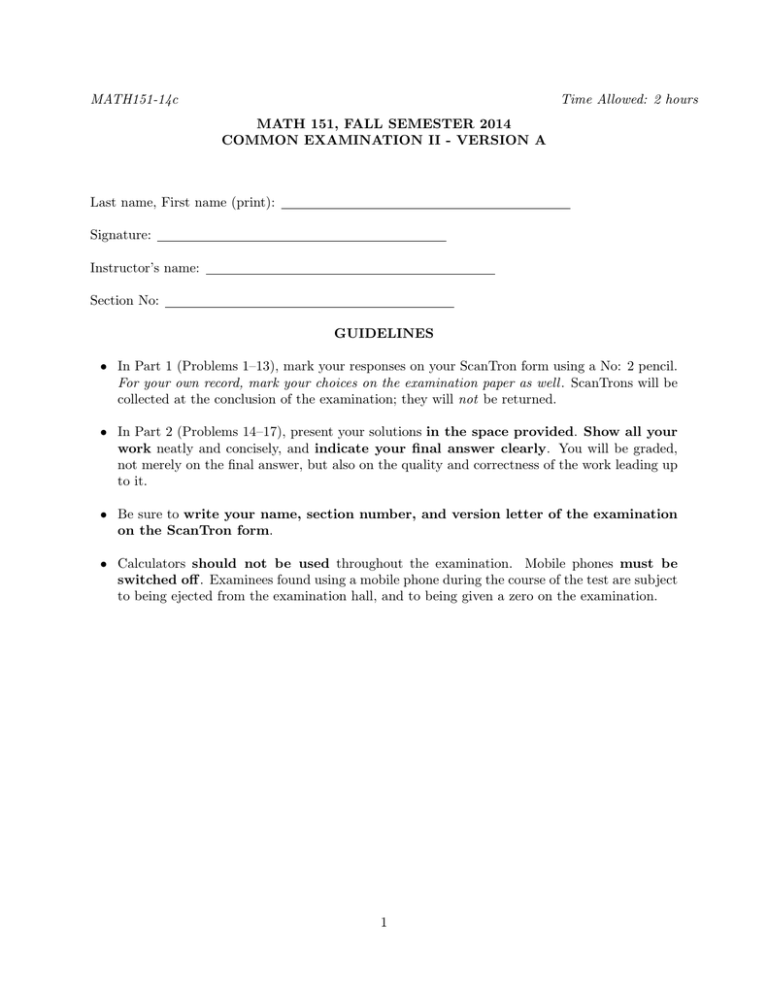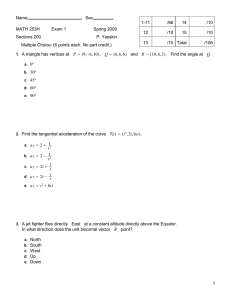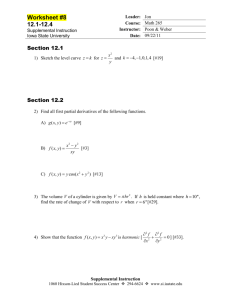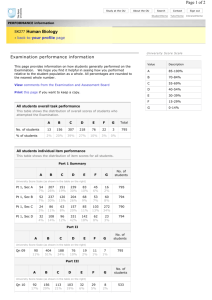MATH151-14c Time Allowed: 2 hours MATH 151, FALL SEMESTER 2014
advertisement

MATH151-14c Time Allowed: 2 hours MATH 151, FALL SEMESTER 2014 COMMON EXAMINATION II - VERSION A Last name, First name (print): Signature: Instructor’s name: Section No: GUIDELINES • In Part 1 (Problems 1–13), mark your responses on your ScanTron form using a No: 2 pencil. For your own record, mark your choices on the examination paper as well . ScanTrons will be collected at the conclusion of the examination; they will not be returned. • In Part 2 (Problems 14–17), present your solutions in the space provided. Show all your work neatly and concisely, and indicate your final answer clearly. You will be graded, not merely on the final answer, but also on the quality and correctness of the work leading up to it. • Be sure to write your name, section number, and version letter of the examination on the ScanTron form. • Calculators should not be used throughout the examination. Mobile phones must be switched off . Examinees found using a mobile phone during the course of the test are subject to being ejected from the examination hall, and to being given a zero on the examination. 1 PART 1 (52 points) Each question is worth 4 points. Mark your responses on the ScanTron form and on the examination paper itself . 1. Let f (x) = (2x + 1) 3/2 (3 + h) (i) lim h→0 3/2 , for x ≥ −1/2. Which of the following equals f 0 (1)? − 33/2 h 3/2 (ii) lim h→0 (3 + 2h) h − 33/2 3/2 (2x + 1) − 33/2 x→1 x−1 (iii) lim (a) (iii) only (b) (ii) and (iii) only (c) (ii) only (d) (i), (ii), and (iii) (e) (i) and (iii) only 2. Let f (x) = x5 + x1/5 , for −∞ < x < ∞. Evaluate f 0 (1). (a) 6 (b) 2 (c) 26/5 (d) 6/5 (e) 24/5 3. Let v denote the velocity of a particle which moves according to the law of motion s(t) = for t ≥ 0, where t is measured in seconds and s in feet. Calculate v(2). (a) 3 25 ft/sec 3 (b) − 25 ft/sec (c) 1 4 ft/sec (d) − 35 ft/sec (e) 3 5 ft/sec 2 t2 t , +1 4. Let C denote the graph of the function f defined by f (x) = x3 − 2x2 , for −∞ < x < ∞. Determine all possible values of x for which the tangent to C at the point (x, f (x)) has slope −1. (a) 1/3 and 1 (b) 2 (c) 0 (d) −1/3 and −1 (e) 0 and 2 5. Consider the function g given by g(x) = (x2 − 1)1/3 , for −∞ < x < ∞. What is the domain of the derivative of g? (a) (−∞, −1) ∪ (1, ∞) (b) (−∞, ∞) (c) (−∞, −1) ∪ (−1, 1) ∪ (1, ∞) (d) (−∞, 1) ∪ (1, ∞) (e) (−∞, −1) ∪ (−1, 0) ∪ (0, 1) ∪ (1, ∞) 6. Let f (θ) = sec θ, for −π/2 < θ < π/2. Compute f 00 (θ). (a) sec θ tan θ (b) sec θ(sec2 θ + tan2 θ) (c) sec3 θ tan θ (d) sec θ(sec2 θ − tan2 θ) (e) − sec θ(sec2 θ + tan2 θ) 7. Let r(t) = π πt 2 , tan (t) , for −π/2 < t < π/2. Compute r0 . π−t 4 (a) h8/9, 4i (b) h−16/9, 4i (c) h16/9, 2i √ (d) h16/9, 2 2i (e) h16/9, 4i 3 8. Let f (x) = p 3+ √ x , for x ≥ 0. Obtain the linear approximation to f near a = 1. (a) 41 (x + 7) (b) 18 (x + 16) (c) 81 (x + 15) (d) 12 (x + 3) (e) 21 (x + 4) 9. Let f (x) = 1 , for x 6= 0. Evaluate f (31) (x). x (a) − x31! 32 (b) 31! x32 (c) − x31! 31 (d) 31! x31 (e) 1 x32 10. Evaluate limπ θ→ 6 (a) (1 + √ [1 + cot(θ)]2 . 1 − csc(9θ) 3)/2 √ (b) 4 + 2 3 (c) (2 + √ 3)/3 √ (d) (4 + 2 3)/3 (e) 2 + √ 11. Compute 3 lim + x→− π 2 3tan(x) . (a) 0 (b) ∞ (c) −∞ (d) 3 (e) 1 4 12. Suppose that the function f is differentiable throughout (−∞, ∞), and let F be the function defined by F (x) = f (x2 − 1) − f (1 − x2 ), for −∞ < x < ∞. Compute F 0 (1). (a) 0 (b) 4f 0 (0) (c) 2f 0 (0) (d) f 0 (1) − f 0 (−1) (e) 4f 0 (1) 13. Let C denote the graph of a differentiable function f . The line x − 2y + 3 = 0 passes through the point (1, f (1)) on C, and is perpendicular to the tangent to C at that point. Evaluate g 0 (1), where g is the function defined by g(x) = x2 f (x). (a) 1 (b) −4 (c) 9/2 (d) 2 (e) 1/2 5 PART 2 (48 points) Present your solutions to the following problems (14–17) in the space provided. Show all your work neatly and concisely, and indicate your final answer clearly. You will be graded, not merely on the final answer, but also on the quality and correctness of the work leading up to it. 14. (12 points) Given that sin(xy) + x cos use Implicit Differentiation to evaluate y 2 + y = π, dy at the point (1, π). dx 6 15. (12 points) Let O(0, 0) denote the origin of the axis of co-ordinates, and let C denote the portion of the parabola y = x2 which lies in the first quadrant. A particle P begins to move from O, along the curve C, in such a way that its distance from the y-axis is increasing at a rate of 3 units per second. How fast is the square of the distance between P and O increasing, at the instant when P crosses the line y = 4? 7 16. Let C denote the curve determined by the following set of parametric equations: x(t) = √ t+4, y(t) = te−t , for − 2 ≤ t ≤ 2. (a) (6 points) Compute x0 (t) and y 0 (t). (b) (2 points) Calculate, in terms of the parameter t, the slope of the tangent to C at the point (x(t), y(t)). (c) (3 points) Use (b) to determine the co-ordinates of the point(s) on C where the tangent to C is horizontal. (d) (5 points) Use (b) to calculate the slope of the tangent to C at the point where the curve crosses the x-axis. Obtain a Cartesian equation of the tangent at that point. 8 17. The graph of a twice-differentiable function f passes through the point (2, −3), and the linear approximation to f near a = 2 is given by L(x) = 3x + B, where B is a constant. (a) (4 points) Determine the value of B. (b) (4 points) Given that f 00 (2) = 4, obtain the quadratic approximation to f near a = 2. 9 LAST NAME (print): FIRST NAME (print): QN PTS 1–13 14 15 16 17 TOTAL 10





